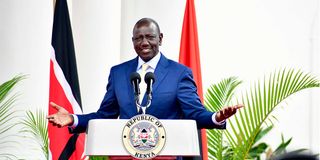Ruto’s borrowing rises to Sh62.1 million an hour

President William Ruto at State House, Nairobi on October 21, 2023.
What you need to know:
- A document tabled in the National Assembly shows that the 11 new loans in US dollars and Euro domination worth Sh223.54 billion are covering the period September 1, 2023 and January 1, 2024.
- This translates to a borrowing craze of Sh44.71 billion a month, Sh1.5 billion a day, Sh62.1 million an hour and Sh1.03 million a minute.
The Government is on the spot for procuring at least Sh1.5 billion a day within five months in new loans to finance various projects according to the National Treasury.
A document tabled in the National Assembly shows that the 11 new loans in US dollars and Euro domination worth Sh223.54 billion are covering the period September 1, 2023 and January 1, 2024.
A breakdown of the loan amount, of which 10 loans are from multilateral lenders and one from a commercial lender, translates to a borrowing craze of Sh44.71 billion a month, Sh1.5 billion a day, Sh62.1 million an hour and Sh1.03 million a minute.
The interest rates on the loans range between 0.25 per cent and 8 per cent.
Section 31 (3) of the Public Finance Management (PFM) Act requires the National Treasury Cabinet Secretary to update parliament on the loans procured by the government.
“At the end of every four months, the Cabinet Secretary shall submit a report to parliament stating the loan balances brought forward, carried down, drawings and amortisations on new loans obtained from outside Kenya or denominated in foreign currency,” the PFM Act states.
The hunger for loans comes as concerns grow over the sustainability of the country’s public debt which stands at Sh11.4 trillion amid depressed revenue streams as well as the harsh forex regime against the Kenyan shilling.
In October 2023, parliament passed an amendment to the PFM Act replacing the Sh10 trillion public debt numerical ceiling with a debt anchor set at 55 per cent of the GDP in net present terms.
This is projected to be achieved by 2029 with the current situation being about 62 percent of the GDP.
The PFM Act also requires National Treasury CS while presenting the report, to state the names and parties to the loan, the amount of the loan and the currency in which it is expressed and in which it is repayable.
The details should also include the terms and conditions of the loan, including interest and other charges and terms of repayment, the amount of the loan advanced at the time the report is submitted, the purpose for which the loan was used and the perceived benefits of the loan.
The loans are geared towards strengthening governance for enabling service delivery and public investment in Kenya, green energy programme, Kenya water security and climate resilience project, Kenya Urban Support Programme, development of county roads and youth empowerment opportunities among others.
The loans include Sh37 billion from the International Development Association (IDA) to finance the second programme for strengthening governance for enabling service delivery and public investment in Kenya.
There is also Sh30.63 billion in syndicated loan from Eastern and Southern African Trade and Development Bank to finance development projects, refinancing or repurchasing of Eurobonds issued and payment of any fees, costs and expenses in connection with the finance documents.
Two loans each of Sh28.58 billion from IDA will finance the financial viability of Kenya Power and increase access to electricity by Kenyans under the Kenya Green and Resilient Expansion of Energy Programme.
One of the loans will be repaid in 11 equal semi-annual repayments from October 2029 through October 2034 and April 2035 with the other in 40 equal semi-annual repayments from October 2028 through to April 2048, October 2048 and April 2053.
The other two loans, each of Sh21.4 billion from IDA will go towards Kenya Urban Support Programme specifically to improve the delivery and resilience of urban infrastructure and services, enhance the private sector engagement in urban planning and support the transition of refugee camps into integrated host communities and refugee settlements.
The two loans mature in 2028 and 2029 and will be paid in 11 and 40 equal semi-annual repayments.
The health emergency preparedness, response and resilience programme will be funded by the Sh17.1 billion sourced from IDA.
The loan seeks to strengthen health system resilience and multi-sectoral preparedness and response to health emergencies in the country.
There is also Sh14.3 billion each from IDA to finance national youth opportunities towards advancement projects by way of increasing employment earnings and promoting savings “for targeted youth at the national scale.”
Other loan amounts are Sh5.8 billion from the OPEC fund for international development for phase I development of urban roads in five Northern Kenya counties project.
The loan is geared towards helping the counties in achieving full economic potential and improving the socio-economic welfare of the population.
The National Treasury document indicates that the project will create new job opportunities because of new transportation possibilities, improved market access and the possibility of labour migration.
The project also seeks to enhance economic development and boost investment as a result of the reductions in travel time and costs.
There is also Sh4.4 billion IDA towards the second additional financing for the Kenya water security and climate resilience project.
The project aims at increasing access to irrigation water for project beneficiaries, enhancing the institutional framework and strengthening capacity for water security and climate resilience in parts of the country.





